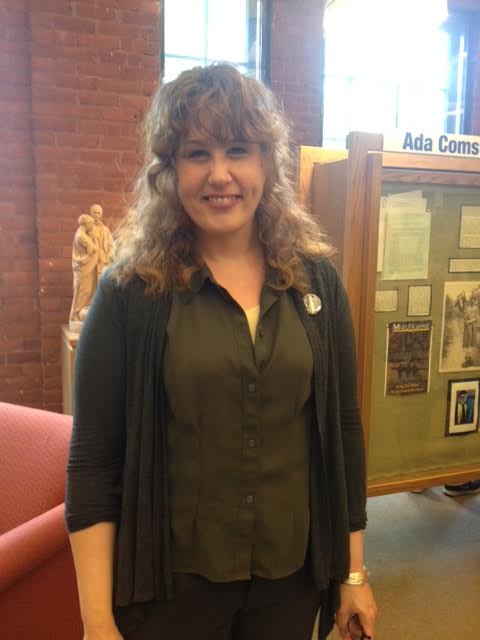'Pioneers in Education': Student Project Captures History of Ada Comstock Program
Research & Inquiry

Published June 17, 2015
While reading the letters of Mabel Allen, Smith class of 1889, for a women’s history assignment spring semester, Ada Comstock Scholar Dianne Jester-Wieland recognized a kindred spirit.
“She wrote about spending hours and hours studying for an exam,” said Jester-Wieland, during a recent presentation on campus. “I couldn’t help feeling a connection to her.”
Jester-Wieland’s studies of the earliest classes of Smithies led to a conclusion she shared with an audience of Ada Comstock alumnae gathered May 22 in the reading room of the College Archives.
“Ada Comstock Scholars, just like the first generation of Smithies, were pioneers in education,” said Jester-Wieland, a single mother of three who entered Smith in 2013. “They also had to overcome obstacles and prove they were smart and worthy.”

Ada Comstock Scholar Dianne Jester-Wieland shared her research on the history of the program with alumnae at Reunion II.
Jester-Wieland’s presentation at Reunion II was the culmination of her capstone project on the history of Smith’s Ada Comstock Scholars Program. The model program, which offers women of nontraditional college age a chance to complete an undergraduate degree, is celebrating its 40thanniversary this year. Since it was founded, more than 2,000 women have graduated as Ada Comstock Scholars.
The capstone research project “was an opportunity to combine two things I’m passionate about: Adas and the archives,” said Jester-Wieland, an American studies major who is pursuing a concentration in archives at Smith. “I wanted to find a way to communicate what the program means to me and so many others.”
The seeds of the Ada Comstock Scholars Program were sown in 1968, when Smith founded a “Mature Women’s Program” for older students, Jester-Wieland said. The success of the 23 women who graduated from that program inspired college leaders to seek other ways to serve women whose education had been interrupted by family or work responsibilities—or for other reasons.
First off, “the program needed a better title,” Jester-Wieland noted, to laughter from the audience.
She credited President Emeritus Thomas Mendenhall and Professor and Dean of the College Emerita Alice Dickinson with creating the program in honor of Ada Comstock, a member of the Smith class of 1897 and the first dean of the college.
The program was officially launched in 1975, the year Jill Ker Conway became Smith’s first woman president. Jester-Wieland noted that from the start, Ada Comstock Scholars were fully integrated at Smith, attending the same classes and fulfilling the same requirements as all other students.
In that way, “the program gives women a chance, not only to get an undergraduate degree, but also to be part of the life of the college,” Jester-Wieland said.
To help “Adas” meet that challenge, Conway and Eleanor Rothman, founding director of the program, worked to secure financial aid, housing and child-care supports for students enrolled as Ada Comstock Scholars.
Rothman, who was among those attending Jester-Wieland’s May 22 talk, said the presentation “did a wonderful job” of portraying the program’s history.
She added that having so many Ada Comstock alumnae present was a reminder of the program’s lasting impact—on Smith and on the broader community.
“These Ada Comstock alumnae are women who went on to accomplish wonderful things in their lives,” Rothman said. “Smith changed their lives and their world.”
Kit Bigelow AC ’80, who was also in the audience, said the Ada Comstock Scholars Program remains an important part of the college’s mission to educate women of promise.
“I’m very involved now in mentoring women, and I notice a lot of the issues we dealt with when the Ada program started are coming back,” said Bigelow, who majored in sociology at Smith and went on to earn an M.B.A.
“Women still need a lot of support at various times in their lives,” Bigelow added. “I hope we can continue the spirit of the program.”
Her classmate, Mary Tondreau ’80, pointed out that “women don’t lead linear lives” or follow a single path to education.
“When we started in the program, colleges weren’t seeking out older students the way many do now,” said Tondreau, who was 28 when she entered Smith. “As soon as I got to Smith, I knew it was home.”
Jester-Wieland said listening to oral histories of Ada Comstock alumnae and reading documents in the College Archives helped her realize “there is no typical Ada Comstock Scholar.”
“Each one brings dedication and life experiences that benefits everyone at the college,” Jester-Wieland explained. “Adas come to Smith not knowing what to expect, and they develop confidence. Smith offers a framework for their personal and intellectual transformations.”
Sid Dalby, associate director of admission and adviser to the Ada Comstock Scholars Program, said Jester-Wieland is a role model for other nontraditional students.
“In addition to her busy family life, Dianne takes full advantage of all that Smith has to offer—in and out of the classroom,” Dalby said. “She continues to blossom as a student and class leader.”
Dalby noted that Jester-Wieland—who is the incoming Ada class president—will spend the summer doing a Praxis internship in admissions and academic services at Greenfield Community College.
Her exhibit on the history of the Ada Comstock Scholars Program—including a memory book that was signed by many of the alumnae who attended the presentation at Reunion— will be displayed in the archives for the next three months.
“What I’ve learned from doing this project is that I’m not alone,” Jester-Wieland said at the conclusion of her talk. “There is a familiar thread that runs through all of us as Adas.”